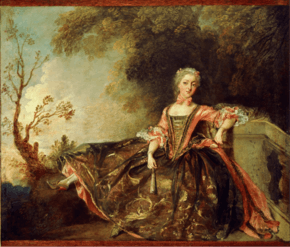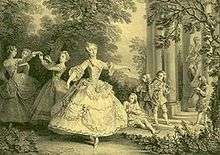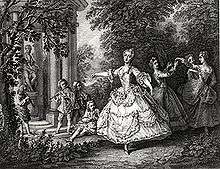Marie Sallé
Marie Sallé (1707–1756) was a French dancer and choreographer in the 18th century known for her expressive, dramatic performances rather than a series of "leaps and frolics" typical of ballet of her time.[1]

Biography
Marie Sallé was a prominent dancer and choreographer in early 18th-century dance. She helped to create ballet d'action (a form continued by her student, Jean-Georges Noverre); she challenged the male-dominated theatrical world; she reformed traditional "feminine" costumes. Born to fairground performers and tumblers in 1707, Marie grew up performing around France with her family.
She made her first public performance with her brother, Francis, at London’s Lincoln's Inn Fields Theatre in 1716. They made their Paris debut at the Saint Laurent fair in 1718 performing La Princesse Charisme, created by Véronique Lesage. In 1725, their family returned to England, but they stayed. The pair is said to have studied with Claude Balon, star of the Paris Opéra, as well as his partner, Françoise Prévost,[2] and fellow dancer at Paris Opera, Michel Blondy. They spent two more seasons at Lincoln's Field Inn, performing dances from George Frideric Handel's opera Rinaldo as well as pantomimes.
Sallé went solo and started performing with the Paris Opera in late 1727. In her premiere, she performed in Jean-Joseph Mouret's Les Amours des Dieux. She danced alongside Marie Camargo, also a student of Prévost; however, they each formed different approaches to their dancing – Camargo as the technician and Sallé as the actress.[3] Her legacy never quite separated from Camargo despite their differing styles. Sallé never settled in at the Paris Opera as she left three times after conflicts with the administration. Nevertheless, she left her mark there, especially during her collaboration with Jean-Philippe Rameau.[4] She continued to London in 1734 for her fourth season. She was engaged by John Rich to perform at Covent Garden. She danced in "Terpsicore," a prologue to a revision of Handel's "Il pastor fido," and in the premieres of the same composer's "Alcina" and "Ariodante."
Also In 1734 she presented her first original, and almost famous work in 1734, Pygmalion,[1] a mythological tale of a statue that comes to life and the sculptor who creates it. This piece made her the first woman to choreograph a ballet in which she also danced. In Pygmalion, Sallé chose to dress in Greek robes, wear her hair down and dance in sandals while playing the role of the statue in an attempt to make it a more realistic characterization. According to Susan Au, her choreography "gave the impression of a danced conversation" (Ballet and Modern Dance 32). During this season, Covent Garden also saw her pantomime Bacchus and Ariadne and her collaboration with Handel.
She returned to Paris in 1735 and choreographed and danced in scenes for Jean-Phillipe Rameau’s opéra-ballets. She retired from the public stage in 1741. However, she continued to dance at court (i.e. to the request of royalty for them and the nobility at court). She taught at the Opéra-Comique in 1743 and, according to her student Jean-Georges Noverre, she practiced daily.[4] Sallé came out of retirement for a few performances at Versailles between 1745-47. She died on June 27, 1756.
Private life and public image
The theatrical scene in 18th century London and Paris was male-dominated and unreceptive to change. Marie Sallé, not only an expressive dancer but also noteworthy choreographer, challenged the boundaries given to women. Her achievements, however, did not receive as much press as her male counterparts mostly likely because – as Christine Battersby theorizes – male writers consciously excluded women from their definitions of creative potential.[3] Therefore, her public image consisted of reports from contemporaries and her reputation. Often, she was described as having a “virginal image” and being virtuous. Images of the rose also followed her after her role in Rameau’s Les Indes Galantes in 1735.
Publicly, Sallé had a reputation of being highly sensual with a mysterious private life. Rumors included a relationship with Manon (Marie) Grognet during 1735. At this time, Sallé was in her mid-thirties and had no heterosexual attachment, thus, colleagues may have used her abstinence as a cover for her casual affairs.[3] All rumors and publications on Sallés sexual or romantic activity had no tangible evidence. Battersby theorizes that the controversial perception of her private life probably was related to the fact that, at the time, Sallé was experiencing success as a choreographer.[3] She later lived in "domestic contentment" with an Englishwoman, Rebecca Wick, whom she named as her "amiable amie" five years prior to her death, when bequeathing her estate to Wick as her sole heir.[5]
Costume Reform
.jpg)
As a choreographer, she integrated music, costumes, and dance styles of her ballets with their themes, thereby anticipating the reforms made by choreographer Jean-Georges Noverre in the late 18th century.[1] She argued that costumes should reflect and represent the character, a novel idea at the time. This engendered a sense of "realism" that had been largely ignored up to this point in the evolution of ballet and also allowed for greater physical freedom among the female dancers, especially, allowing them more opportunities without the restrictions of unwieldy and elaborate clothing on stage. She changed the costume from heavy long dress to muslin flowing material which caused shock and delight. She often performed without a skirt or bodice (sans-paniers), rebelling against the traditional costume and accepted gender norms of a very regimented era.[1] She also worked in collaboration with composers such as George Frideric Handel and Christoph von Gluck, commissioning compositions from them for her choreography, which helped to garner more respect for ballet as its own distinct art form.


See also
References
- Garfunkel, Trudy (1994). On wings of joy : the story of ballet from the 16th century to today (1st ed.). Little, Brown and Co. pp. 19–22. ISBN 978-0316304122.
- Mackrell, [edited by] Debra Craine, Judith (2000). The Oxford Dictionary of Dance. Oxford University Press. p. 358. ISBN 978-0198601067.CS1 maint: extra text: authors list (link)
- McCleave, Sarah. "Sallé, Marie". Grove Music Online. Retrieved 14 Aug 2013.
- Ed. Selma Jeanne Cohen and Dance Perspectives Foundation. "The International Encyclopedia of Dance"(1998), Oxford University Press, published online: 2005,ISBN 9780195187632
- Ballerina: Sex, Scandal, and Suffering Behind the Symbol of Perfection, by Deirdre Kelly; Greystone Books Ltd; 2014, p. 34.
Further reading
- McCleave, Sarah. "Marie Sallé, a Wise Professional Woman of Influence” Women’s Work: Making Dance in Europe before 1800, Lynn Matluck Brooks (Ed.), University of Wisconsin Press, 2007, pp. 160– 181.
- Schmidt, Carl B. "Dance (opera)", Grove Music Online ed L. Macy (Accessed 3 April 2007), grovemusic.com, subscription access.
- Hogwood, Christopher. Handel (1988), Thames and Hudson, ISBN 0-500-27498-3.
- Au, Susan. Ballet and Modern Dance (1988), Thames and Hudson, ISBN 0-500-20352-0.
- Ed. Selma Jeanne Cohen and Dance Perspectives Foundation. "The International Encyclopedia of Dance" (1998), Oxford University Press, published online: 2005, ISBN 9780195187632, http://www.oxfordreference.com/view/10.1093/acref/9780195173697.001.0001/acref-9780195173697-e-1523?rskey=GQwkE4&result=1, Accessed October 22. 2017.
- Highfill, P. H., et al A Biographical Dictionary of Actors, Actresses, Musicians, Dancers, Managers & Other Stage Personnel in London, 1660-1800, Volume 13, by Philip H. Highfill, Kalman A. Burnim, and Edward A. Langhans; SIU Press, 1991, p. 184.